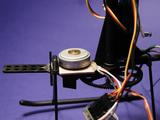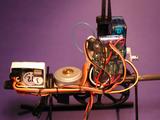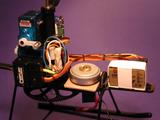 The brushless motor is a CDROM motor. My CDROM
motor page describes the motor. The controller is a Castle
Creations Phoenix 10 brushless sensorless ESC with BEC. The tail motor is
the standard motor with the HF-9 (heli version) ESC.
The brushless motor is a CDROM motor. My CDROM
motor page describes the motor. The controller is a Castle
Creations Phoenix 10 brushless sensorless ESC with BEC. The tail motor is
the standard motor with the HF-9 (heli version) ESC.
Click on any photo for a full size image.
 The brushless motor is a CDROM motor. My CDROM
motor page describes the motor. The controller is a Castle
Creations Phoenix 10 brushless sensorless ESC with BEC. The tail motor is
the standard motor with the HF-9 (heli version) ESC.
The brushless motor is a CDROM motor. My CDROM
motor page describes the motor. The controller is a Castle
Creations Phoenix 10 brushless sensorless ESC with BEC. The tail motor is
the standard motor with the HF-9 (heli version) ESC.
The controller is the Castle Creations Phoenix 10 and the tail rotor controller is the HF-9 heli verion. The gyro is a Century Picco gyro.
8/11/02
 Finally finished installing the motor and other parts. I use the
Hornet fiberglass blades, which privide more stability and lift than
the stock blades. This heli is 138 grams without battery, while my
original Piccolo with the Orion motor is 164 grams without battery.
That's a savings of almost an ounce.
Finally finished installing the motor and other parts. I use the
Hornet fiberglass blades, which privide more stability and lift than
the stock blades. This heli is 138 grams without battery, while my
original Piccolo with the Orion motor is 164 grams without battery.
That's a savings of almost an ounce.
The first flight tests show that the tail ESC shuts down after the main rotor is running at about 75% of the speed needed for liftoff. (I'm really happy that I decided to buy a second Piccolo to work on this motor - it would be frustrating to be without a heli to fly while I debug this problem. A second machine allows me to make comparisons between the two machines for debugging and for performance checks after I figure out the problem.) Changing batteries and battery types makes some difference, but not significantly. What's really bad about this bug is that with an 8-cell NiMh pack, I can get the heli to lift off, but then the tail rotor ESC will shut down while in flight. The different packs tried are:
I tested the current draw on both Piccolo helicopters. The Orion-equipped Piccolo (Picc#1) draws about 2.5A at hover. The brushless CDROM motor equipped Piccolo (Picc#2) draws 1.5A when light on its skids (when I was able to keep the tail rotor running). The batteries should be able to supply this amount of current without causing a problem for the HF9. However, the Phoenix 10 has a very large capacitor on its power leads. Perhaps the current draw of the motor is high, causing enough of a voltage drop on the HF9's power leads to cause it to reset. I'm using the 2-pin DEANS micro connectors that are good for carrying the amount of current that these helis need.
Some interesting tidbits:
Since the heli weighs so little with the new motor, I tried two battery packs - one for the main rotor and one for the tail rotor with the negative leads tied together. This combination works great. So something in the power supply is causing the HF9 to die.
Someone else ran into a problem with interactions between the main rotor ESC and the HF9 and the solution was to install a diode in the positive battery lead to the HF9 and a capacitor across the HF9 power leads (after the diode). The cathode (banded end of the diode) needs to be connected to the HF9 and the anode to the battery. The capacitor goes from the diode cathode to the negative lead (ground). I used a 3 amp capacity diode from Radio Shack and a 35uF electrolytic capacitor.
The diode and capacitor fixed the problem. I was able to hover for over ten minutes without the HF9 shutting down. The current draw is 2.0A at hover with a 3-cell 17670 LiIon pack that weighs 112 grams. These cells are fairly old and removed from an old laptop, so they are not of the best quality. I was able to hover for about 10 minutes tonight on a pack that I was using for a variety of testing prior to an extended hover.
The performance is greater than the Orion motor on two 18650 LiIon
cells. It is much like the Orion equipped Piccolo on eight 720mAh NiMh
cells in terms of ability to climb. It is also a very stable bird -
lifting off smoothly and directly. I've not had to change anything but
trim settings on my transmitter. One nice thing is that I don't have
to use the idle-up switch to cause the HF9 to initialize.


Well, the problems are not completely fixed. I had noticed some minor tail wagging from the Piccolo. The twitching is the main rotor ESC burping. It is smooth at low RPM, but when it approaches hover speed, it begins to burp or hesitate every 1/2 second to 3 seconds. Some of the burps are long enough that when the motor kicks back in, the tail ESC dies. I have the diode and 250uF@16v capacitor on the HF9 input now. Adding something similar to the Gyro is a good suggestion, but I don't think the problem lies there. I think it is something with the Phoenix 10 ESC. The Phoenix LED is signaling something a various times, so I just sent Patrck a note at CC to ask if he can share what the light sequences mean.
The burping is not receiver glitching, because the servos and tail rotor ESC don't burp.
Paul Goelz suggested running it without the Gyro to see what difference that makes. There was no difference. I did discover that there was more glitching at one throttle setting and that the servos did seem to be moving at the same time. Trying an FMS double conversion receiver didn't fix the problem, so it isn't related to the receiver, unless the power to the receiver is causing it to have problems too.
I reprogrammed the Phoenix 10 to use 12-15 degree timing advance and the burping has disappeared. I checked the other timing advance settings and they both produce the burping. It may be that the timing advance is needed with my particular CDROM motor and at the speeds at which it is turning. The burping happened only at mid-throttle setting, not at low speeds or at very high speeds. I don't know enough details of how this particular motor and speed control combination interact to explain exactly why the burping is occuring at the other timing settings.
I had an Astro 010 here for another project and couldn't resist installing it on my brushless Piccolo to see how it would work. I'm now using the 3-pin DEANS connectors to connect the Phoenix 10 ESC to the brushless motors, so it makes changing motors quick and easy.
The Astro 010 works well with three LiIon cells or with 8 NiMh cells. It won't fly above ground effect on two LiIon cells like my Orion equipped Piccolo does.
In my quest of keeping the batteries light for my Piccolo, I rewound the CDROM motor for 16 turns (originally 19). It has the same burping problem as when it had 19 turns. It can get the Piccolo off the ground now, but not out of ground effect with two 18650 LiIon cells. I'm using a 10-tooth pinion. Switching to an 11 or 12 tooth pinion make get it in the air. Perhaps I should have tried the larger pinion with the higher turn motor which has more torque. It's time to get out that other CDROM drive and build another motor, order some more pinions, and try a bunch of experiments.